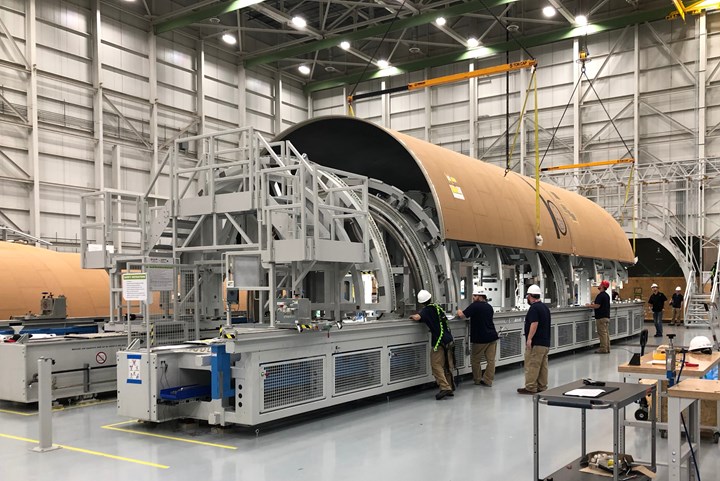To boldly go . . .
Space travel is a challenge, even if filmmakers like to make us think otherwise.

Manufacture of spacecraft payload fairings at RUAG Space (Bern, Switzerland; renamed to Beyond Gravity) in Decatur, Ala., U.S., from CW senior editor Scott Francis’s recent plant tour. CW Photo | Scott Francis
I was just nine years old in 1977 when the first movie from the Star Wars franchise was released. I was 52 in 2019 when the 11th and final movie was released. By virtue of its longevity and sheer quantity of films, Star Wars has become the de facto source of our understanding of traveling through and living in space, augmented by other notable space-based films and television series, including 2001: A Space Odyssey, Star Trek, the Alien series, Interstellar, The Martian, Gravity, Battlestar Galactica (classic and reboot) and, more recently, First Man and The Expanse.
One of the things that has enabled all of these depictions, and has helped draw audiences to them, is the special effects made possible by rapidly advancing computer technology. I remember, in 1977, watching Star Wars for the first time, and feeling like a whole new reality was unfolding before me, replete with hovercraft, speed-of-light space travel, laser weapons and tractor beams.
I also remember, in 1977, not worrying one bit about how the world depicted in Star Wars violated innumerable laws of physics — particularly those governing space travel. Star Wars, and many of the films and shows that followed, took great liberties depicting momentum, gravity, radiation, pressure and temperature in ways designed primarily to drive plot and action. I also think many of us are willing to suspend our disbelief regarding the physics of space travel in exchange for an entertaining story.
Perhaps the most realistic — and harrowing — movie about space travel was 1995’s Apollo 13, which was the true story of the third NASA mission, in 1970, intended to land American astronauts on the moon. Two days into the mission, the oxygen tank in Apollo 13’s service module failed, and the mission was aborted. The astronauts were forced to find a way to get back to Earth with limited oxygen supply. What made the Apollo 13 film so compelling was its realism — because it was based on actual events, the movie’s makers were forced to depict realistically the daunting physical challenge of the mission such as dwindling air supply, limited power, cold and wet cabin conditions and more. As faithful as this treatment was, however, it is the exception to the rule.
A result of this, I fear, is that many of us underestimate just how difficult it is to get people aboard a spacecraft into space and safely to their destination. First, you have to overcome Earth’s gravity and the air resistance of its atmosphere. After that, you face the task of directing the craft toward its target — the International Space Station (ISS), the moon, Mars, etc. Today it costs about $1,000 to deliver 1 kilogram into low-Earth orbit (99 to 1,200 miles altitude), and a whole lot more to travel further.
Consider, for instance, that since the Space Shuttle program ended in 2011, the United States has not had a vehicle with which to take astronauts to the ISS. We hope to change this soon. Boeing and SpaceX are each working on spacecraft that will ferry astronauts to and from ISS. Boeing’s is called Starliner; SpaceX calls its craft Crew Dragon. These craft have been years in the making, and both have had successes and failures emblematic of the trial and error associated with space development programs. Both also hope to deliver humans to ISS within the year.
Of course, the ultimate goal is to travel to the moon and eventually Mars, and doing so will require smart use of composites. One company in the thick of this effort is RUAG Space, which is working on out-of-autoclave fabrication of massive carbon fiber composite structures for the Atlas and Vulcan launch vehicles and is a supplier to Boeing’s Starliner program. RUAG Space was kind enough to open the doors of its Decatur, Ala., U.S., plant to CW senior editor Scott Francis.
If we do eventually put humans on Mars, the effort most assuredly will be governed by the laws of physics, which means it will be expensive, challenging and rewarding. And it will, no doubt, also be a movie.
Related Content
Plant tour: Joby Aviation, Marina, Calif., U.S.
As the advanced air mobility market begins to take shape, market leader Joby Aviation works to industrialize composites manufacturing for its first-generation, composites-intensive, all-electric air taxi.
Read MoreManufacturing the MFFD thermoplastic composite fuselage
Demonstrator’s upper, lower shells and assembly prove materials and new processes for lighter, cheaper and more sustainable high-rate future aircraft.
Read MoreCryo-compressed hydrogen, the best solution for storage and refueling stations?
Cryomotive’s CRYOGAS solution claims the highest storage density, lowest refueling cost and widest operating range without H2 losses while using one-fifth the carbon fiber required in compressed gas tanks.
Read MorePlant tour: Middle River Aerostructure Systems, Baltimore, Md., U.S.
The historic Martin Aircraft factory is advancing digitized automation for more sustainable production of composite aerostructures.
Read MoreRead Next
Plant tour: Daher Shap’in TechCenter and composites production plant, Saint-Aignan-de-Grandlieu, France
Co-located R&D and production advance OOA thermosets, thermoplastics, welding, recycling and digital technologies for faster processing and certification of lighter, more sustainable composites.
Read More“Structured air” TPS safeguards composite structures
Powered by an 85% air/15% pure polyimide aerogel, Blueshift’s novel material system protects structures during transient thermal events from -200°C to beyond 2400°C for rockets, battery boxes and more.
Read MoreVIDEO: High-volume processing for fiberglass components
Cannon Ergos, a company specializing in high-ton presses and equipment for composites fabrication and plastics processing, displayed automotive and industrial components at CAMX 2024.
Read More






















